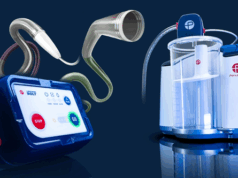
Women with significant pelvic vein incompetence are likely to have haemorrhoids, which could suggest a causal link, according to research from a varicose vein clinic.
Judy Holdstock (Whiteley Clinic, London) told the Charing Cross Symposium (5–8 April; London, UK) that pelvic vein incompetence was a common problem, affecting approximately 20% of women with leg varicose veins. Of 56 women with both pelvic vein incompetence and haemorrhoids studied via transvaginal scan at the clinic, virtually all had reflux in both internal iliac veins and one-third also had involvement of the left ovarian vein.
Holdstock told the meeting: “Haemorrhoids are associated with the more extensive patterns of trunk reflux and more importantly are associated directly with internal iliac reflux.” However, she said it was not clear whether the haemorrhoids were caused by pelvic vein reflux, whether they were exacerbated by pelvic vein reflux, or if this was an incidental finding.
The review was conducted among 593 female patients with varicose veins presenting to the clinic over one year, of whom 153 were scanned transvaginally because of a reflux pattern suggestive of pelvic involvement. Holdstock commented that women with varicose veins frequently have symptoms suggestive of pelvic venous congestion: “Many report the symptoms of pelvic congestion syndrome ranging from throbbing and aching in the lower back to irritable bowel and bladder, and dyspareunia, and many report a history of haemorrhoids.”
Transvaginal scans were conducted with the patient supine with their head and torso elevated to 45 degrees, using colour flow Doppler and asking them to perform the Valsalva manoeuvre to test for reflux. The sonographers assessed internal iliac veins, ovarian veins, peri-anal veins and haemorrhoids, looked for reflux of greater than one second in trunks and tributaries of over 5mm, and persistent reflux in tributaries or trunks of less than 5mm. They also looked for the dilation of venous trunks on Valsalva.
Of women given a scan, 113 (74%) were found to have significant pelvic vein incompetence, and 56 (36%) had haemorrhoids. Holdstock said: “Initially we thought we would be looking at an ovarian vein nutcracker phenomenon; however, this is seen in less than 5% of our series.”
Assessment of venous competence revealed that reflux was more significant in each of the pelvic trunks in the 56 women with haemorrhoids compared to the 97 without. Eighty five per cent of those with haemorrhoids had right internal iliac vein involvement compared to 52% of those without, while left internal iliac vein involvement was apparent in 82% of the women with haemorrhoids compared to 53% of those without. The left ovarian vein was involved in 73% of the women with haemorrhoids compared to 39% of those without.
Holdstock said: “When we looked at the statistics in the haemorrhoid group a third of them had that three-vessel pattern, virtually the entire group had involvement of both internal iliac veins with no patients having reflux in ovarian veins only in this group. Comparing the haemorrhoid to non- haemorrhoid group, reflux was more significant in each of the pelvic trunks in the haemorrhoid group.”
Holdstock said the clinic was now going to conduct a prospective study in which a colorectal surgeon would refer female patients with symptomatic haemorrhoids for transvaginal ultrasound to assess pelvic vein reflux.
She commented that among all 153 women who were scanned, the most common pattern was for three-vessel involvement: “Both internal iliacs are the most common to reflux, the least common being the right ovarian. The most common patterns we find are bilateral internal iliac vein involvement and the left ovarian in a quarter of the group. Ten per cent of the group have failure of all four veins. Isolated left ovarian vein reflux was present in only 1.3% of the group.”









